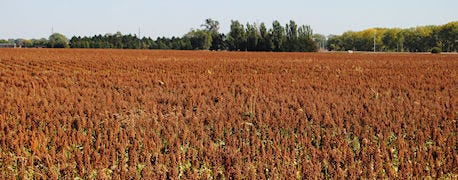
Over the past 15 years, grain sorghum plantings in Nebraska have fallen off by almost 75%. In 2012, only 165,000 acres were planted to sorghum in the state.
If sorghum is to make a comeback, new uses and new research will be needed to improve genetics and to provide new ways to utilize this versatile crop. One of the ongoing research projects that is being conducted at the USDA Agricultural Research Service in Lincoln looks at modifying lignin within sorghum genetics to provide greater potential for cellulosic and thermal bioenergy.

Sorghum Research Looks at Manipulating Lignin
One process in the manufacture of biofuels is through cellulosic biomass being broken down into sugars that can be fermented into biofuels. Cell wall lignin plays an important role in that break down process.
Over the past 30 years, ARS sorghum research has found brown midrib, or bmr, mutants that reduce lignin content and alter lignin composition in the cellulosic biomass of sorghum, according to USDA ARS research molecular biologist, Scott Sattler. Seed companies and numerous government agencies and academic institutions, including the University of Nebraska, have bmr germplasm, particularly in forage-type sorghums, Sattler says.
As part of the studies, specific bmr genes, including bmr6 and bmr12, have been identified by researchers to impair the last steps in lignin synthesis. If lignin synthesis can be disrupted, this would increase ethanol production efficiency.
This is just the beginning. The goal is to find new genes and new ways to impair lignin. "We identified more mutants different from bmr6 and bmr12," Sattler says. "Now, we'd like to see what they do to improve digestibility for cattle or efficiency in cellulosic ethanol production. The goal is to see how low we can push lignin biologically and get a plant that still survives."
So far, studies have found that bmr6 and bmr12 do not increase susceptibility to fungal pathogens like stalk rot, and in fact, may in some instances perform a tad better than wild type sorghum, he says.
This project has also developed grain sorghum germplasm with white grain and tan plants, which could potentially serve the special target audience of gluten-free food producers for consumers with celiac disease. At the same time, Sattler says that ARS researchers have found that tan plants producing white grain still have a good level of resistance to grain mold and other pathogens.
You can learn more about this project by reading an upcoming print article in Nebraska Farmer or by contacting Sattler at 402-472-5987.
About the Author(s)
You May Also Like






